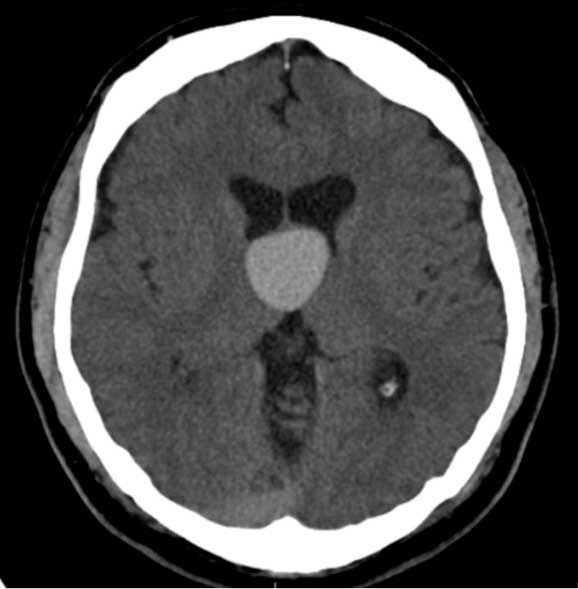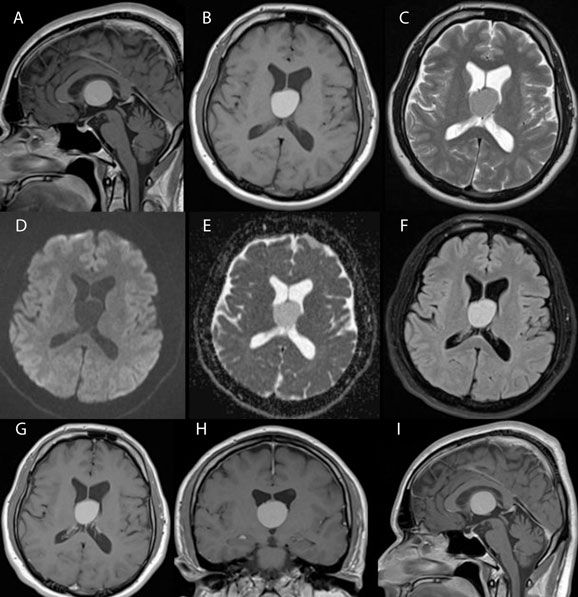Colloid Cysts
A 38-year-old male presents with headache.
Case history: A 38-year-old male presents with headache.

Figure 1: Non-contrast head CT showing a hyperattenuating mass is in the region of the foramen of the Monro. Ventricles are symmetric. No hydrocephalus.

Figure 2: MRI of the brain: A-I Round T1 hyperintense and T2 hypointense lesion in the region of the foramen of Monroe. There is no enhancement on post-contrast images. The ventricles are normal in size. There is no restricted diffusion on DWI - ADC sequences. No enhancement on post-contrast images.
Diagnosis: Colloid cysts
Background : Colloid cysts usually present in early to mid-adulthood, between the third and fifth decades, and account for less than 1 percent of all primary intracranial tumors and up to 15 percent of all intraventricular tumors. The name reflects the typical contents of the cyst, from the Greek word kollodes (resembling glue).
These tumors are generally wedged in the foramen of Monro, attached to the anterosuperior portion of the third ventricular roof between the columns of the fornices. The pillars of the fornices involve the cyst. Histological and immunocytochemical analysis have documented that colloid cysts originate when ectopic endodermal elements migrate into the velum interpositum during development of the central nervous system and not from neuroectoderm.
Clinical features: Most of the times, symptoms are size dependent. Small lesions remain asymptomatic and are detected only incidentally. Larger tumors usually present with symptoms of intermittent hydrocephalus, including intermittent headache and vomiting. Death from sudden, acute obstruction has been reported. Other symptoms reported include neuropsychologic deficits such as depression, personality changes, as well as olfactory/gustatory hallucinations. Anterograde amnesia has been reported with forniceal damage. Typically, surgical resection is curative, and is recommended for all cysts larger than 7 mm in diameter.
Colloid cysts are round cystic lesions filled with mucinous material, hemorrhagic products, and ions (sodium, magnesium, calcium, copper, silicon, aluminum, phosphorus, and iron), and are lined by a single layer of pseudostratified columnar cells with occasional PAS-positive goblet cells.
Image findings: They are well-circumscribed, spherical and most of the times hyperdense on CT. On MRI, these lesions will appear hyperintense on T1W images and hypointense on T2W images. A thin rim of peripheral enhancement can occasionally be seen after contrast administration.
Depending on the mucopolysaccharide content, the cyst may exhibit variable attenuation on CT and variable signal intensity characteristics on MR. The key is to identify this lesion based on its location within the anterior roof of the third ventricle. Classically, these cysts do not present with any calcification. Despite the mucopolysaccharide content, these cysts do not restrict diffusion.
Differential diagnoses: CSF flow artifact (MR pseudo-cyst) caused by pulsatile turbulent CSF flow around the foramen of Monro can be thought to be a colloid cyst. Rarely a neurocysticercosis cyst may occur at the foramen of Monro. Subependymoma or choroid plexus papilloma that may take place at the foramen of Monro are much less common and typically enhance by contrast media.
Raquel Bezerra, MD
fellow at Georgetown University Hospital, Washington, DC
GE HealthCare Debuts AI-Powered Cardiac CT Device at ACC Conference
April 1st 2025Featuring enhanced low-dose image quality with motion-free images, the Revolution Vibe CT system reportedly facilitates improved diagnostic clarity for patients with conditions ranging from in-stent restenosis to atrial fibrillation.
The Reading Room: Racial and Ethnic Minorities, Cancer Screenings, and COVID-19
November 3rd 2020In this podcast episode, Dr. Shalom Kalnicki, from Montefiore and Albert Einstein College of Medicine, discusses the disparities minority patients face with cancer screenings and what can be done to increase access during the pandemic.
Can Photon-Counting CT be an Alternative to MRI for Assessing Liver Fat Fraction?
March 21st 2025Photon-counting CT fat fraction evaluation offered a maximum sensitivity of 81 percent for detecting steatosis and had a 91 percent ICC agreement with MRI proton density fat fraction assessment, according to new prospective research.